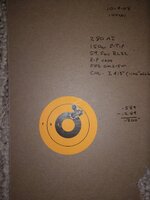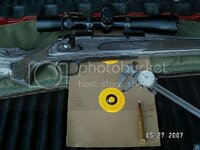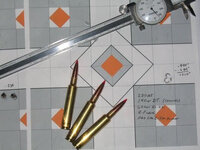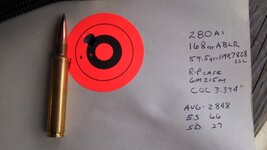longrangehunter
Handloader
- Jun 19, 2011
- 1,749
- 550
I was going to PM Dr Mike to ask him what I’m going to spell out here, but instead why not share it!?!
Over twenty years ago I had a Jarrett 280AI built, along with two loads that came with the rifle. A 150 Nosler BT behind a stiff load of IMR4831, alongside a 175 Partition with just as stout load of IMR7828.
Not withstanding that those loads were developed at 203’ above sea level, and I was living in Montana above my town of 5550’. Those loads blew the primers out on me when I went to test fire the gun. They also came with three targets for each load and a data card for them. It was 3150 for the 150 BT, and 2950 for the 175 PT.
A quick phone call to fix the issue was obviously reduce the charges on both loads. Which wasn’t a problem since he also sent me 200 pieces of FF 280 Remington brass to 280 AI.
The 150 BT came down one or two grains to 58.5, and for the 175 PT to 59.0. Which cleared up the blown primmer issues.
The question is why is Hodgdon so low in the velocity department vs what Nosler is listing?
Sure, I’ve seen plenty of slow barrels and some really fast ones in my life time. So there’s that, barrel and chamber dimensions, different components, bullet seating depths and lot to lot variations in smokeless gun powders, etc.
I want to avoid that portion of the equation, only to focus on how let’s begin with PO Ackley vs Art Alphin of A Square Ammunition Co. who I knew used testing equipment for pressure during his load development work.
At the time I had this rifle there was no reloading manuals for the 280 AI, so people incorrectly or correctly assumed the improved ballistics of the cartridge design….. And while some might have gone one way, others may have gone to the extreme… Way over pressure.
At the time I just took what was shown for a Remington 280 and increased the powder charge weight by 5% in all the different reloading manuals for a given bullet weight and took the average of them combined for the same powder.
I still have my notes, and when I looked at a few months ago the Hodgdon manual for a given powder it was the same as what I had for the same powder from a 5% increase over a 280 Rem.
Ok, so I have 50 rounds left over from my Jarrett Rifle and wanted to ask Dr Mike if I should just dismantle them, or test fire them in my new rifle? I know that they will be way faster than even listed in the Nosler book I have.
It’s definitely a better action, but that’s not how I’d look at it now that I’m older and wiser to the situation.
Hodgdon used a Swift AFrame 175 SP for their data, and a pathetically slow velocity of only 2686 ft./s with 56.5 of IMR7828ssc in a 24” bbl.
Nosler lists 2772 with 58.0 grains of IMR7828ssc in their 24” H-S Precision rifle with the 175 PT/ABLR bullet(s).
I used to get around 2900 with the 175 PT in my 24” barreled Jarrett using 59.0 grains.
It should be rather clear by now that I’m getting too. The hard data that is published today vs what people used previously to determine whether or not they were within the context of safely being prudent or extremely overzealous with speed!!
What do you say Dr Mike?
Over twenty years ago I had a Jarrett 280AI built, along with two loads that came with the rifle. A 150 Nosler BT behind a stiff load of IMR4831, alongside a 175 Partition with just as stout load of IMR7828.
Not withstanding that those loads were developed at 203’ above sea level, and I was living in Montana above my town of 5550’. Those loads blew the primers out on me when I went to test fire the gun. They also came with three targets for each load and a data card for them. It was 3150 for the 150 BT, and 2950 for the 175 PT.
A quick phone call to fix the issue was obviously reduce the charges on both loads. Which wasn’t a problem since he also sent me 200 pieces of FF 280 Remington brass to 280 AI.
The 150 BT came down one or two grains to 58.5, and for the 175 PT to 59.0. Which cleared up the blown primmer issues.
The question is why is Hodgdon so low in the velocity department vs what Nosler is listing?
Sure, I’ve seen plenty of slow barrels and some really fast ones in my life time. So there’s that, barrel and chamber dimensions, different components, bullet seating depths and lot to lot variations in smokeless gun powders, etc.
I want to avoid that portion of the equation, only to focus on how let’s begin with PO Ackley vs Art Alphin of A Square Ammunition Co. who I knew used testing equipment for pressure during his load development work.
At the time I had this rifle there was no reloading manuals for the 280 AI, so people incorrectly or correctly assumed the improved ballistics of the cartridge design….. And while some might have gone one way, others may have gone to the extreme… Way over pressure.
At the time I just took what was shown for a Remington 280 and increased the powder charge weight by 5% in all the different reloading manuals for a given bullet weight and took the average of them combined for the same powder.
I still have my notes, and when I looked at a few months ago the Hodgdon manual for a given powder it was the same as what I had for the same powder from a 5% increase over a 280 Rem.
Ok, so I have 50 rounds left over from my Jarrett Rifle and wanted to ask Dr Mike if I should just dismantle them, or test fire them in my new rifle? I know that they will be way faster than even listed in the Nosler book I have.
It’s definitely a better action, but that’s not how I’d look at it now that I’m older and wiser to the situation.
Hodgdon used a Swift AFrame 175 SP for their data, and a pathetically slow velocity of only 2686 ft./s with 56.5 of IMR7828ssc in a 24” bbl.
Nosler lists 2772 with 58.0 grains of IMR7828ssc in their 24” H-S Precision rifle with the 175 PT/ABLR bullet(s).
I used to get around 2900 with the 175 PT in my 24” barreled Jarrett using 59.0 grains.
It should be rather clear by now that I’m getting too. The hard data that is published today vs what people used previously to determine whether or not they were within the context of safely being prudent or extremely overzealous with speed!!
What do you say Dr Mike?








